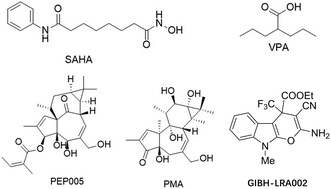Structure-optimized dihydropyranoindole derivative GIBH-LRA002 potentially reactivated viral latency in primary CD4+ T lymphocytes of chronic HIV-1 patients†
Abstract
Based on structure modification and a high-throughput Jurkat-Lat cell screening model, we found that GIBH-LRA002, ethyl-2-amino-3-cyano-9-methyl-4-(trifluoromethyl)-4,9-dihydropyrano[2,3-b]indole-4-carboxylate, effectively reactivated the latent proviruses in a Jurkat-Lat cell line and primary CD4+ T cells from both chronic SIV-infected rhesus macaques and HIV-1 patients but without inducing systemic activation, making this compound attractive for potentially treating HIV-1 infection.



 Please wait while we load your content...
Please wait while we load your content...